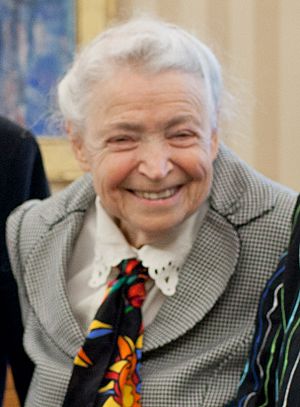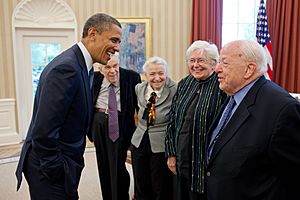Mildred Dresselhaus facts for kids
Quick facts for kids
Mildred Dresselhaus
|
|
|---|---|

Dresselhaus at the White House in 2012
|
|
| Born |
Mildred Spiewak
November 11, 1930 Brooklyn, New York, U.S.
|
| Died | February 20, 2017 (aged 86) Cambridge, Massachusetts, U.S.
|
| Alma mater |
|
| Known for | Carbon nanotubes |
| Spouse(s) |
Frederick Reif
(divorced)Gene Dresselhaus
(m. 1958, |
| Awards |
|
| Scientific career | |
| Fields | Applied physics |
| Institutions | |
| Doctoral students |
|
Mildred Dresselhaus (born Mildred Spiewak; November 11, 1930 – February 20, 2017) was an amazing American scientist. She was often called the "Queen of Carbon Science." She studied very tiny materials, a field called nanotechnology.
Mildred Dresselhaus was a top professor at the Massachusetts Institute of Technology (MIT). She won many important awards for her work. These included the Presidential Medal of Freedom and the National Medal of Science.
Contents
Early Life and Education
Mildred Dresselhaus was born in Brooklyn, New York City, on November 11, 1930. Her parents were immigrants from Poland. Her family faced tough times during the Great Depression. Mildred helped her family earn money from a young age. She did small assembly jobs at home. She also worked in a zipper factory during summer breaks.
Mildred's first teaching job was tutoring another student. She earned fifty cents a week. This experience taught her how to be a good teacher. She loved New York's free museums. Places like the American Museum of Natural History sparked her interest in science. She also learned about music and art at the Greenwich House Music School.
Mildred grew up in the Bronx. Her older brother told her about Hunter College High School. She did very well there. She also practiced teaching by helping her classmates.
College Years
Mildred went to Hunter College in New York. It was mainly a women's college. But during her time, it also welcomed many male students. These men were soldiers returning from war. They could go to college with help from the G.I. Bill.
At Hunter, one of her professors noticed Mildred's talent. This professor, Rosalyn Yalow, later won a Nobel Prize. She encouraged Mildred to study physics. Mildred earned her first college degree in 1951.
Advanced Studies
After Hunter College, Mildred continued her studies. She went to the University of Cambridge in England. She also studied at Harvard University. She earned her Master's degree from Radcliffe College.
In 1958, she earned her PhD from the University of Chicago. There, she learned from Enrico Fermi, a Nobel Prize winner. After her PhD, she did more research at Cornell University. Then, she joined the MIT Lincoln Laboratory.
Career and Impact
Mildred Dresselhaus worked at the Massachusetts Institute of Technology for 57 years. She became a visiting professor in 1967. In 1968, she became a permanent professor. By 1985, she was the first woman to be named an "Institute Professor" at MIT. This is a very high honor.
She studied special materials. These materials became very important in modern science. Mildred became a top expert in this field. Her early work helped other scientists discover graphene. Graphene is a super-thin material made of carbon. Two scientists, Andre Geim and Konstantin Novoselov, won the Nobel Prize in 2010 for their work on graphene.
Mildred Dresselhaus received the National Medal of Science in 1990. This was for her research on materials. It was also for helping more women get into science and engineering. In 2014, she received the Presidential Medal of Freedom. This is one of the highest awards in the U.S.
She also held important leadership roles. She was a director at the United States Department of Energy. She led the American Institute of Physics. She was also the first female president of the American Association for the Advancement of Science.
Many of her students became famous scientists. These include Deborah Chung and Greg Timp.

Some scientific ideas are named after her. The Hicks-Dresselhaus Model helps us understand how heat moves in tiny materials. The SFDD model helped predict how carbon nanotubes would behave. However, the Dresselhaus effect is named after her husband, Gene Dresselhaus, who was also a famous scientist.
Mildred Dresselhaus worked hard to help women in physics. In 1971, she started the first Women's Forum at MIT. This was a place to talk about women's roles in science. The American Physical Society created the Millie Dresselhaus Fund in her honor. This fund supports women in physics. She even appeared in a General Electric TV ad. The ad asked, "What if female scientists were celebrities?" It aimed to get more women into science and engineering jobs.
In 2019, the Institute of Electrical and Electronics Engineers (IEEE) created a new award. It's called the IEEE Mildred Dresselhaus Medal. It honors great technical work in science and engineering.
Scientific Discoveries
Mildred Dresselhaus was famous for her work on graphite. Graphite is a form of carbon, like what's in pencil lead. She also studied fullerenes and carbon nanotubes. These are tiny carbon structures. She looked at how these materials conduct electricity and heat.
Her research helped create technology using thin graphite. This allows electronics to be "everywhere." Think about how thin and flexible smartphones are becoming. Her work helped make this possible.
In the 1960s, lasers became available. Mildred used lasers to study materials. This led to new ways of understanding graphite. A big part of her research focused on "buckyballs" (a type of fullerene) and graphene. She especially studied the electrical properties of carbon nanotubes. She also looked at how to improve the heat-carrying properties of nanowires.
Personal Life
Mildred Dresselhaus was married twice. Her first husband was physicist Frederick Reif. Later, she married Gene Dresselhaus. He was also a well-known scientist. They had four children: Marianne, Carl, Paul, and Eliot. They also had five grandchildren.
Honors and Awards
Mildred Dresselhaus received many awards and honors:
- IEEE Medal of Honor, 2015 (first woman to receive it)
- National Inventors Hall of Fame induction, 2014
- Presidential Medal of Freedom, 2014
- Kavli Prize in Nanoscience, 2012
- Enrico Fermi Award, 2012 (second woman to receive it)
- Vannevar Bush Award, 2009 (second woman to receive it)
- Oliver E. Buckley Condensed Matter Prize, 2008
- Oersted Medal, 2007
- L'Oréal-UNESCO Awards for Women in Science, 2007
- Heinz Award for Technology, the Economy and Employment, 2005
- IEEE Founders Medal Recipients, 2004
- National Medal of Science, 1990
- Member of the National Academy of Sciences (U.S.), 1985
- Member of the American Academy of Arts and Sciences, 1974
- Society of Women Engineers Achievement Award, 1977
Images for kids
-
President Barack Obama greets Dr. Mildred Dresselhaus and Dr. Burton Richter, May 7, 2012.
See Also
 In Spanish: Mildred Dresselhaus para niños
In Spanish: Mildred Dresselhaus para niños


